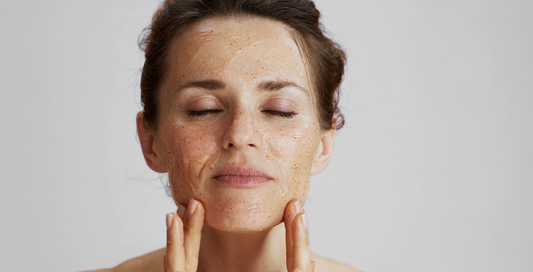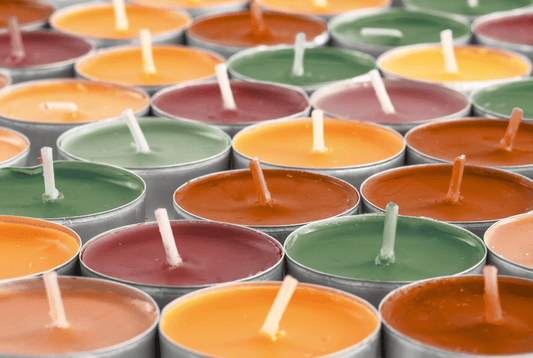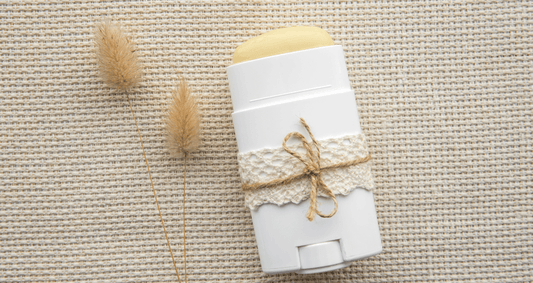Want to unclog your pores and improve skin texture? Exfoliators are a great way to remove dead skin cells, leaving you with soft, smooth skin!
Buildup of dead skin cells, dirt, and bacteria can lead to skin issues such as breakouts and clogged pores, but regular exfoliation helps prevent these problems.
We’ve created a simple exfoliator cream recipe that is gentle on the skin and hydrating!
Content
- Why Make Your Own Exfoliator?
- What is Colloidal Oatmeal?
- Exfoliator Cream Recipe
- How to Use an Exfoliator
Why Make Your Own Exfoliator?
Some exfoliators can be too harsh for the delicate skin on the face and cause more damage than good. Our recipe makes a super gentle exfoliator that is great for all skin types, including those with sensitive skin!
Many commercial exfoliators use chemical substances as their exfoliating component. However, this can be harsh on the skin, especially for dry and sensitive skin types. Making your own homemade face exfoliator means you control what goes on your skin!

What is Colloidal Oatmeal?
Colloidal oatmeal is a light colored powder with some coarse pieces, produced by grinding whole oats into a fine powder. It is very gentle on the skin, making it suitable for all skin types, especially sensitive, dry, itchy and oily skin.
Colloidal oatmeal provides gentle exfoliation and can be used to remove dead skin cells. It is very soothing on the skin and can also help to alleviate itchiness in itchy or dry skin.
Exfoliator Cream Recipe
This creamy exfoliator recipe is great for those who want to try more intermediate recipes. It makes a luxurious, moisturising exfoliator!
Ingredients:
- Water 74g | 74ml
- Vegetable glycerin 5g | 3ml
- Hydroxyethyl cellulose 0.5g
- Geogoard ultra 1.5g
- Emulsifying wax 3g
- Argan oil 10g | 10ml
- Colloidal oatmeal 5g
Method:

1. Heated water phase
- Weigh out the water, vegetable glycerin, hydroxyethyl cellulose, geogard ultra in a heatproof container.
- Heat the mixture over a pan of boiling water or in a double boiler.
- Mix well until the geogard ultra has dissolved.
- Remove from the heat and leave to cool slightly.

2. Heated oil phase
- Weigh the argan oil and emulsifying wax in a separate container.
- Heat over a pan of boiling water or in a double boiler.
- Mix well until the wax has melted.
- Once fully combined, remove from the heat.

3. Cool down phase
- Add the liquid oil mixture to the water solution.
- Blend with a stick blender in short pulses for 1-2 minutes.
- Once blended, sieve in the colloidal oatmeal and mix until it is evenly distributed.
- Leave the mixture to cool to around 25°C and stir occasionally.

5. Test the pH
- The pH of exfoliator should be in the range 4.5 - 5.5
- Take 2g of the exfoliator and mix it in 18g of water until dissolved.
- Using a digital pH meter, measure the pH.

6. If necessary, adjust the pH
- If the pH of your exfoliator is too low, make a sodium hydroxide solution.
- Put on your gloves, mask and safety goggles. For more information about safety when using sodium hydroxide, click here.
- Weigh 10g of sodium hydroxide and 90g of water.
- Add the sodium hydroxide to the water and stir until dissolved.
- Using a pipette, add 0.5g of the sodium hydroxide solution into the diluted exfoliator sample that you used for pH testing.
- Test the pH again, if the pH is still under 4.5, repeat the last steps until the pH is 4.5-5.5.
- Once the correct pH has been reached, record the amount of sodium hydroxide solution needed and add this to the remaining exfoliator.
- If the pH of the exfoliator was over 5.5, you can follow this process but use 10g citric acid diluted in 90g water.

7. Pour into containers
- Pour the mixture into a container of your choice.
- Now your exfoliator is ready to use!
How to Use an Exfoliator?
Before using the exfoliator for the first time, perform a patch test on a small area of skin to check for sensitivities or allergies.
Apply a small amount of the exfoliator to cleansed skin and gently massage it into the skin using a circular motion, avoiding the sensitive eye area. Gently remove the excess with a flannel or by rinsing your face with warm water. Rinsing with cold water afterward can help soothe the skin and close pores.
In your skincare routine, you should use the exfoliator after your cleanser and apply your serums or moisturiser after the exfoliator. We recommend using the exfoliator 2 times a week.
Continue Reading
Now you know how to make a homemade face scrub, why not try more recipes?
- Want radiant skin with a hydrating serum? Make your own hyaluronic acid serum!
- Make your own body scrub with our coarse sea salt scrub recipe!
- Interested in face masks? Try our charcoal face mask recipe!
How did your homemade face scrub turn out? Let us know in the comments!



